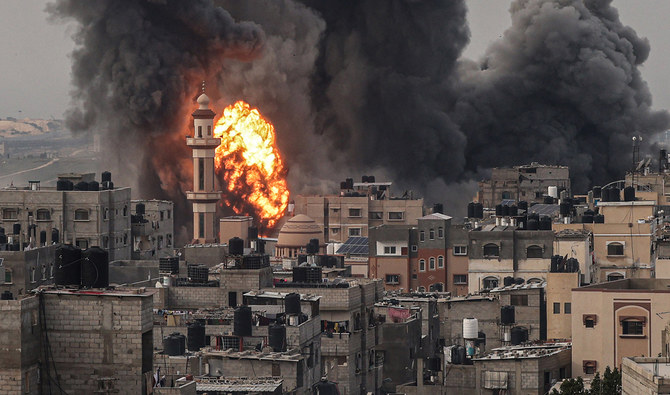Hopes rise for Israel-Hamas truce deal as Gaza toll hits 20,000

While some talked of a truce, fighting raged and Gaza’s government said the death toll in the Palestinian territory reached 20,000.
Right-wing Israeli Prime Minister Benjamin Netanyahu said there can be no Gaza ceasefire until Hamas fighters are destroyed, but Washington expressed hope the truce talks can bring results.
“These are very serious discussions and negotiations we hope that they lead somewhere,” National Security Council spokesman John Kirby said.
US Secretary of State Antony Blinken also voiced hope for a new pause in fighting.
“We remain very actively engaged in seeing if we can get a pause back on and hostages moving out again,” he said.
The comments came after Netanyahu, under pressure from Washington and other allies over civilian casualties, said fighting would not stop until all objectives are achieved: “the elimination of Hamas, the release of our hostages and the end of the threat from Gaza.”
He had informed the families of some of the 129 prisoners who were still being held in Gaza late on Tuesday that he had twice sent the head of the Mossad espionage agency “to Europe to promote a process to free our hostages.
Families of hostages have Protested to Netanyahu
Families of hostages have protested to Netanyahu, requesting an immediate agreement to release them.”Danger exists at all times while the hostages are there. They don’t have time,” stated 17-year-old Dutch-Israeli ex-prisoner Ofir Engel. This week, Qatari Prime Minister Sheikh Mohammed bin Abdulrahman Al Thani and CIA Director Bill Burns had a “positive meeting” in Warsaw, according to a person who was briefed on the discussions and asked not to be identified but told AFP that they had taken place.
Talks were continuing “intending to reach an agreement around the release of the remaining hostages in Gaza in exchange for a truce and the potential release of Palestinians held in Israeli prisons,” according to a source.
Supported by Egypt and the US, Qatar assisted in mediating the first week-long ceasefire last month, which resulted in the release of 80 Israeli prisoners in return for 240 Palestinian ones.
Ismail Haniyeh, the head of Hamas located in Qatar, travelled to Egypt to hold discussions with Abbas Kamel, the head of that nation’s security services.
Speaking to AFP in Gaza
Speaking to AFP in Gaza on Wednesday under the pseudonym “a total ceasefire and a retreat of the Israeli occupation army from the Gaza Strip is a precondition for any serious negotiation” on a captive-prison swap, a Hamas official stated.
According to a source close to Hamas, ideas for the Egypt negotiations would centre on a week-long truce that would see the release of forty Israeli hostages.
Haniyeh met Iranian Foreign Minister Hossein Amir-Abdollahian before departing Qatar, yet no information was made public.
In Rafah, where explosions had left fireballs and smoke rising, many expressed optimism that negotiations would be successful.
“I want there to be a stop to the ongoing deaths and sufferings, as well as a total truce. It has been over 75 days,” 25-year-old Kassem Shurrab remarked.
A ceasefire, according to 63-year-old Palestinian refugee Bassil Khoder, would benefit both Israelis and Palestinians alike.
We also live next door to Jews,” he remarked. “We won’t give up on them.”
Two bombs were captured on camera by AFPTV live on Wednesday, striking Rafah, in southern Gaza, which is where many of the estimated 1.9 million displaced people in the enclave have fled.
Israeli strikes on Rafah
Israeli strikes on Rafah “were targeted” and resulted in the deaths of at least 12 Palestinians, according to the Gaza Health Ministry. Later, it was reported that an Israeli strike that struck two houses east of Khan Yunis claimed the lives of at least thirty more individuals.
As they dug with shovels and a backhoe to try to free the victims, crowds of people surrounded the debris. On the blood-stained ground, one blackened body was covered by a blue blanket.
Over 300 attacks and close-quarters fighting have been reported by the Israeli army in the last day.
It stated that Yahya Sinwar, the head of the resistance movement in Gaza, and other Hamas commanders had been exposed by forces to a network of tunnels. In a film that it published, the military claimed to have shown the “large network” connecting hiding places and homes around Palestine Square in Gaza City.
Due to disagreements over phrasing, the UN Security Council postponed voting on a resolution requesting a stop in hostilities once more. The new time for the vote is Thursday morning.
Prior to this, the US blocked a ceasefire resolution.
Since imposing a complete closure on Gaza at the beginning of the conflict, Israel has let relief vehicles pass via both its own Kerem Shalom crossing and the Rafah border crossing with Egypt.
First Direct Relief Convoy from Jordan
In its first direct relief convoy from Jordan, the World Food Programme announced on Wednesday that it had sent food through Kerem Shalom and issued a “risk of starvation” warning.
Diseases are spreading, communications have been cut off on multiple occasions, and fuel, water, and medical supplies are also in short supply.
In a scheme spearheaded by the United Arab Emirates, the Israeli military agency COGAT said that it had begun constructing a pipeline from Egypt to supply potable water from a mobile desalination plant.
Israeli Foreign Minister Eli Cohen endorsed plans to transfer humanitarian aid from the Mediterranean island to Gaza while he was in adjacent Cyprus.
Through this channel, we hope to expedite the delivery of humanitarian aid to Gaza,” he declared. Fears of a regional escalation have been aroused by the war, as Houthi fighter missiles have disrupted Red Sea shipping and there have been firefights over the border with Lebanon.








